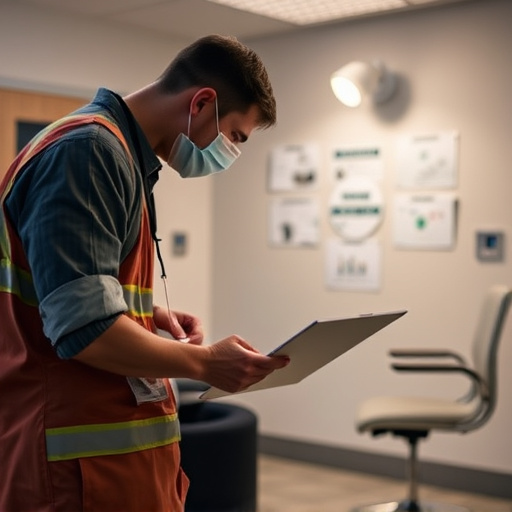Workers' Compensation Injury Care is a critical system ensuring prompt medical attention, rehab, and financial support for on-the-job injuries, reducing costs and improving recoveries. However, lengthy waiting times negatively impact patients' quality of life and return to work. Telemedicine is revolutionizing care through virtual consultations, reduced wait times, efficient triaging, and streamlined claims processes. Best practices for employers include immediate incident reporting, prompt notifications, first aid kits, partnerships with medical facilities, and regular training, all aimed at quicker interventions, proactive rehab, and a safer work environment.
In today’s fast-paced world, immediate access to treatment is paramount, especially for workers compensation injury care. However, traditional waiting times can be detrimental, causing delays in recovery and increased costs. This article delves into the challenges posed by lengthy wait times and explores innovative solutions, with a focus on telemedicine, to expedite medical services. We also discuss streamlining claims processes and best practices for employers to ensure quick and quality injury care, ultimately improving worker outcomes.
- Understanding Workers' Compensation and Injury Care: A Brief Overview
- Challenges of Traditional Waiting Times in Treatment
- Innovative Solutions for Accelerated Access to Medical Services
- The Role of Telemedicine in Reducing Wait Times
- Streamlining Claims Process: Efficient Workers' Comp Administration
- Best Practices for Employers: Ensuring Quick and Quality Injury Care
Understanding Workers' Compensation and Injury Care: A Brief Overview

Workers’ Compensation and Injury Care play a crucial role in ensuring swift access to treatment for employees injured on the job. This system is designed to provide immediate medical attention, rehabilitation, and financial support to workers, minimizing downtime and facilitating their return to work. In many countries, workers compensation insurance is mandatory for employers, covering a range of workplace injuries and illnesses.
Understanding this process is essential for both employees and employers. It clarifies rights and responsibilities, expedites claims, and ensures that injured workers receive the care they need without undue delay. Efficient navigation of workers’ compensation can lead to quicker recoveries, reduced costs, and an improved work environment through proactive injury prevention measures.
Challenges of Traditional Waiting Times in Treatment

The traditional model of healthcare, particularly for workers compensation injury care, often involves lengthy waiting times before patients can access treatment. This can be a significant challenge, especially for those dealing with acute or chronic pain that requires immediate attention. Long wait times lead to increased patient distress, reduced quality of life, and potential exacerbation of injuries.
Moreover, in the case of workers compensation claims, prolonged delays can negatively impact an injured worker’s ability to return to work, causing financial strain and further complicating their recovery journey. These challenges highlight the need for innovative solutions that prioritize quick access to treatment, ensuring patients receive timely care without compromising the quality of services.
Innovative Solutions for Accelerated Access to Medical Services

In today’s digital era, innovative solutions are revolutionizing access to medical services, especially for those dealing with workers compensation injuries. Telemedicine and virtual care platforms enable injured workers to connect with healthcare professionals promptly, eliminating traditional waiting times. This shift towards remote consultations not only enhances convenience but also ensures faster assessments, diagnoses, and treatment plans, which are crucial in managing pain and promoting recovery.
Additionally, advanced digital health records and streamlined communication tools facilitate seamless collaboration between medical specialists, insurers, and employers. Such coordination optimizes the claims process for workers compensation injury care, ensuring that injured employees receive timely interventions, minimizing disruptions to their work routines, and fostering a more productive recovery journey.
The Role of Telemedicine in Reducing Wait Times

Telemedicine has emerged as a powerful tool in transforming healthcare access, especially for individuals seeking workers compensation injury care. By facilitating virtual consultations and remote monitoring, telemedicine bridges the gap between patients and healthcare providers, significantly reducing wait times. This is particularly beneficial for those dealing with work-related injuries, where prompt medical attention can expedite recovery and prevent prolonged downtime.
Through secure video conferencing, patients can connect with specialists from the comfort of their homes or workplaces. This not only saves time but also ensures accessibility for individuals who may face challenges in physically reaching healthcare facilities, especially in remote areas. Additionally, telemedicine allows for efficient triaging, enabling medical professionals to assess and prioritize patient needs, thereby reducing overall wait times for essential workers compensation injury care.
Streamlining Claims Process: Efficient Workers' Comp Administration

Streamlining the claims process is a vital aspect of enhancing quick access to treatment for workers’ compensation injuries. Efficient administration plays a crucial role in ensuring timely care, which can significantly impact an injured worker’s recovery and return to work. By implementing modern systems and well-trained staff, the process becomes more manageable. This efficiency means faster processing of claims, reducing the time between injury and treatment.
Skilled administrators prioritize communication, keeping all parties informed throughout. They also ensure that medical records are accurately captured and easily accessible, enabling prompt evaluations and recommendations for suitable care. This streamlined approach not only benefits workers by expediting their road to recovery but also employers, who can better manage costs and maintain a productive workforce.
Best Practices for Employers: Ensuring Quick and Quality Injury Care

To ensure quick and quality injury care for their employees, employers should implement best practices grounded in efficiency and comprehensive understanding of workers’ compensation policies. This includes establishing clear protocols for immediate incident reporting, prompt notification to insurance providers, and setting up efficient communication channels between all relevant parties. Employers should also invest in well-equipped first aid kits tailored to the specific risks associated with their industry, enabling on-site immediate care.
Furthermore, fostering relationships with nearby medical facilities and specialists can significantly reduce wait times for specialized treatment. Regular training sessions for both employees and management on workers’ compensation procedures and emergency response protocols are essential. These measures not only expedite injury care but also contribute to a safer work environment by encouraging early intervention and proactive rehabilitation.














